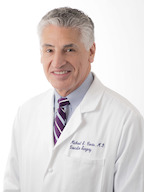Raynaud's Syndrome
| UCSF Vascular surgeons have extensive expertise and experience in the care of patients with Raynaud's Syndrome, from common forms to the most complex and challenging cases, such as severe Reynaud's phenomenon that involves pronounced digital ischemia and the risk of losing one or more fingers or toes, a hand, foot or limb. Learn more about the care provided by the UCSF Center for Limb Preservation and Wound Care to prevent a leg amputation in a Raynaud's patient. Read the full story ... |
Raynaud's is a rare disorder that affects the arteries. Arteries are blood vessels that carry blood from your heart to different parts of your body.
Raynaud's is sometimes called a disease, syndrome, or phenomenon. The disorder is marked by brief episodes of vasospasm (VA-so-spazm), which is a narrowing of the blood vessels.
Vasospasm of the arteries reduces blood flow to the fingers and toes. In people who have Raynaud's, the disorder usually affects the fingers. In about 40 percent of people who have Raynaud's, it affects the toes. Rarely, the disorder affects the nose, ears, nipples, and lips.
Overview
There are two main types of Raynaud’s—primary and secondary.
If you have primary or secondary Raynaud's, cold temperatures or stress can trigger "Raynaud's attacks." During an attack, little or no blood flows to affected body parts.
As a result, the skin may turn white and then blue for a short time. As blood flow returns, the affected areas may turn red and throb, tingle, burn, or feel numb.
In both types of Raynaud's, even mild or brief changes in temperature can cause Raynaud's attacks. For example, taking something out of the freezer or being exposed to temperatures below 60 degrees Fahrenheit can cause your fingers to turn blue.
Raynaud's
Figure A shows arteries in the fingers (digital arteries) with normal blood flow. The inset image shows a cross-section of a digital artery. Figure B shows fingertips that have turned white due to blocked blood flow. Figure C shows narrowed digital arteries, causing blocked blood flow and blue fingertips. The inset image shows a cross-section of a narrowed digital artery.
Most people who have Raynaud's have no long-term tissue damage or disability. However, people who have severe Raynaud's can develop skin sores or gangrene from prolonged or repeated Raynaud's attacks. "Gangrene" refers to the death or decay of body tissues.
Outlook
About 5 percent of the U.S. population has Raynaud's. For most people who have primary Raynaud's, the disorder is more of a bother than a serious illness. They can usually manage the condition with minor lifestyle changes.
Secondary Raynaud's may be harder to manage. However, several treatments are available to help prevent or relieve symptoms. With secondary Raynaud's, it's important to treat the underlying disease or condition that's causing it.
Researchers continue to look for better ways to diagnose and treat Raynaud's.
Causes
In primary Raynaud’s (also called Raynaud’s disease), the cause isn't known. Primary Raynaud's is more common and tends to be less severe than secondary Raynaud's.
Secondary Raynaud’s is caused by an underlying disease, condition, or other factor. This type of Raynaud's is often called Raynaud's phenomenon.
Causes of Secondary Raynaud's
Many things can cause secondary Raynaud's. Examples include:
- Diseases and conditions that directly damage the arteries or damage the nerves that control the arteries in the hands and feet
- Repetitive actions that damage the nerves that control the arteries in the hands and feet
- Injuries to the hands and feet
- Exposure to certain chemicals
- Medicines that narrow the arteries or affect blood pressure
Diseases and Conditions
Secondary Raynaud's is linked to diseases and conditions that directly damage the arteries. The disorder is also linked to diseases and conditions that damage the nerves that control the arteries in the hands and feet.
For example, Raynaud’s occurs in most people who have scleroderma (skler-o-DER-ma). It also is a common problem for people with lupus.
Other examples of diseases and conditions that can cause Raynaud's include:
- Rheumatoid (RU-ma-toyd) arthritis
- Atherosclerosis (ath-er-o-skler-O-sis)
- Blood disorders such as cryoglobulinemia (KRI-o-GLOB-yu-li-NE-me-ah) and polycythemia (POL-e-si-THE-me-ah)
- Sjögren's (SHOW-gren's) syndrome, dermatomyositis (DER-ma-to-mi-o-SI-tis), and polymyositis (POL-e-mi-o-SI-tis)
- Buerger's disease
Thyroid problems and pulmonary hypertension may also cause Raynaud's.
Repetitive Actions
Repetitive actions that damage the arteries or the nerves that control the arteries in the hands and feet may lead to Raynaud's.
Typing, playing the piano, or doing other similar movements repeatedly over long periods may lead to secondary Raynaud's. Using vibrating tools, such as jackhammers and drills, may also raise your risk of developing Raynaud's.
Hand or Foot Injuries
Injuries to the hands or feet from accidents, frostbite, surgery, or other causes can lead to Raynaud's.
Chemicals
Exposure to certain workplace chemicals can cause a scleroderma-like illness that's linked to Raynaud's. An example of this type of chemical is vinyl chloride, which is used in the plastics industry.
The nicotine in cigarettes can also raise your risk of developing Raynaud's.
Medicines
Certain medicines can cause secondary Raynaud's, including:
- Migraine headache medicines that contain ergotamine. This substance causes the arteries to narrow.
- Certain cancer medicines, such as cisplatin and vinblastine.
- Some over-the-counter cold and allergy medicines and diet aids. Some of these medicines can narrow your arteries.
- Beta blockers. These medicines slow your heart rate and lower your blood pressure.
- Birth control pills. These medicines can affect blood flow.
Risk Factors
The risk factors for primary Raynaud's (Raynaud's disease) and secondary Raynaud's (Raynaud's phenomenon) are different.
The risk factors for primary Raynaud's include:
- Gender. Women are more likely to have primary Raynaud's than men.
- Age. Primary Raynaud's usually develops before the age of 30.
- Family history. Primary Raynaud's may occur in members of the same family.
- Living in a cold climate. Cold temperatures can trigger Raynaud's attacks.
The risk factors for secondary Raynaud's include:
- Age. Secondary Raynaud's usually develops after the age of 30.
- Certain diseases and conditions. For example, diseases that directly damage the arteries or damage the nerves that control the arteries in the hands and feet may cause secondary Raynaud's. (For more information, go to "What Causes Raynaud's?")
- Injuries to the hands or feet.
- Exposure to certain workplace chemicals, such as vinyl chloride (used in the plastics industry).
- Repetitive actions with the hands, such as typing or using vibrating tools.
- Certain medicines, such as migraine, cancer, cold/allergy, or blood pressure medicines.
- Smoking.
- Living in a cold climate.
Signs and Symptoms
People who have primary Raynaud's (Raynaud's disease) or secondary Raynaud's (Raynaud's phenomenon) can have attacks in response to cold temperatures or emotional stress.
Raynaud's attacks usually affect the fingers and toes. Rarely, the attacks affect the nose, ears, nipples, or lips.
During a Raynaud's attack, the arteries become very narrow for a brief period. As a result, little or no blood flows to affected body parts. This may cause these areas to:
- Turn pale or white and then blue
- Feel numb, cold, or painful
- Turn red, throb, tingle, burn, or feel numb as blood flow returns to the affected areas
Raynaud's attacks can last less than a minute or as long as several hours. Attacks can occur daily or weekly.
Attacks often begin in one finger or toe and move to other fingers or toes. Sometimes only one or two fingers or toes are affected. Different areas may be affected at different times.
Severe secondary Raynaud's can cause skin sores or gangrene. "Gangrene" refers to the death or decay of body tissues. Fortunately, severe Raynaud's is rare.
Diagnosis
Your doctor will diagnose primary Raynaud's (Raynaud's disease) or secondary Raynaud's (Raynaud's phenomenon) based on your medical history, a physical exam, and test results.
Specialists Involved
Primary care doctors and internists often diagnose and treat Raynaud's.
If you have the disorder, you also may see a rheumatologist. This is a doctor who specializes in treating disorders of the joints, bones, and muscles.
Rheumatologists diagnose and treat many of the diseases that are linked to secondary Raynaud's, such as scleroderma and lupus.
Medical History
Your doctor may ask about your risk factors for Raynaud's. He or she also may ask about your signs and symptoms when you're exposed to cold temperatures or stress.
For example, your doctor may ask whether your fingers or toes:
- Feel numb or painful when they're exposed to cold temperatures
- Turn white or blue, or both, when they're exposed to cold temperatures
Physical Exam
Your doctor will look at your fingers and toes to check the health of your skin and nails and to check blood flow to these areas.
Your doctor also may do a more complete physical exam to check for signs of diseases and conditions that are linked to secondary Raynaud's.
Diagnostic Tests and Procedures
Your doctor may recommend the following tests to check for Raynaud's and related conditions:
Cold Stimulation Test
A cold stimulation test can be used to trigger Raynaud's symptoms. For this test, a small device that measures temperature is taped to your fingers. Your hands are then exposed to cold—they're usually briefly put into ice water.
Your hands are then removed from the cold, and the device measures how quickly your fingers return to their normal temperature. If you have Raynaud's, it may take more than 20 minutes for your fingers to return to their normal temperature.
Because results of this type of test are not always consistent, your doctor may do other tests to check for Raynaud’s.
Nailfold Capillaroscopy
You may have a test called nailfold capillaroscopy (KAP-ih-lar-OS-ko-pe). For this test, your doctor puts a drop of oil at the base of your fingernail. He or she then looks at your fingernail under a microscope.
If your doctor sees abnormal arteries, it may mean you have a disease linked to Raynaud's, such as scleroderma.
Other Tests
Your doctor may order blood tests to look for conditions that are linked to secondary Raynaud's. Examples include antinuclear antibody (ANA), erythrocyte sedimentation rate (ESR or "sed rate"), and C-reactive protein (CRP) blood tests.
Treatment
Primary Raynaud's (Raynaud's disease) and secondary Raynaud's (Raynaud's phenomenon) have no cure. However, treatments can reduce the number and severity of Raynaud's attacks. Treatments include lifestyle changes, medicines, and rarely, surgery.
Most people who have primary Raynaud's can manage the condition with lifestyle changes. People who have secondary Raynaud's may need medicines in addition to lifestyle changes. Rarely, they may need surgery or shots.
If you have Raynaud's and develop sores on your fingers, toes, or other parts of your body, see your doctor right away. Timely treatment can help prevent permanent damage to these areas.
Lifestyle Changes
Lifestyle changes can help you avoid things that may trigger a Raynaud's attack. Examples of such triggers include cold temperatures, emotional stress, workplace or recreational factors, and contact with certain chemicals or medicines.
Protect Yourself From Cold Temperatures
To protect yourself from cold temperatures:
- Wear a hat, mittens (rather than gloves), scarf, coat with snug cuffs, and warm socks and shoes during cold weather. Layer your clothing for extra warmth.
- Put hand and foot warmers in your mittens, boots, socks, or pockets. Some warmers are small heat packs, and others are battery-operated. These warmers are often available at sporting goods stores.
- Turn down air conditioning, or dress warmly while in an air-conditioned space.
- Warm up your car before driving in cold weather.
- Wear gloves or mittens when taking food out of the refrigerator or freezer (if cold temperatures severely affect you).
Avoid Other Triggers
Try to avoid things that make you upset or stressed. Learn ways to handle stress that you can't avoid. Physical activity helps some people cope with stress. Other people listen to music or focus on something calm or peaceful to reduce stress. Some people learn yoga, tai chi, or meditation.
Try to avoid workplace and recreational triggers. For example, limit the use of vibrating tools, such as drills. Wear proper protective gear if you work with industrial chemicals. Also, try to limit repetitive hand actions, such as typing or playing the piano.
Some medicines can trigger Raynaud's attacks. Examples include:
- Migraine headache medicines that contain ergotamine. This substance causes your arteries to narrow.
- Certain cancer medicines, such as cisplatin and vinblastine.
- Over-the-counter cold or allergy medicines or diet aids. Some of these medicines can narrow your arteries.
- Beta blockers. These medicines slow your heart rate and lower your blood pressure.
- Birth control pills. These medicines can affect blood flow.
Talk with your doctor about whether your medicines are safe for you.
Other Lifestyle Changes
Other lifestyle changes also can help you avoid Raynaud's attacks. For example, include physical activity as part of your healthy lifestyle. Physical activity can increase your blood flow and help keep you warm.
Limit your use of caffeine and alcohol. These substances can trigger Raynaud's attacks. If you smoke, quit. Smoking makes Raynaud's worse. Ask your doctor about programs and products that can help you quit. Also, try to avoid secondhand smoke.
You also can take steps to help stop Raynaud's attacks when they occur. For example:
- Move to a warmer spot, such as indoors, during cold weather.
- Warm your hands or feet. Place your hands under your armpits. Soak your feet or hands in warm water.
- Wiggle or massage your fingers and toes.
- Move your arms in circles or shake your arms or feet.
- Get out of stressful situations and try relaxation techniques.
If you have Raynaud's, be sure to take care of your hands and feet. Protect them from cuts, bruises, and other injuries. For example, wear properly fitted shoes and don't walk barefoot. Use lotion to prevent your skin from drying and cracking. Also, avoid tight wristbands and rings.
Medicines and Surgery
If lifestyle changes don't control Raynaud's, you may need medicines or surgery. Medicines are used to improve blood flow to the fingers and toes.
Examples of medicines used to treat Raynaud's include calcium channel blockers, alpha blockers, prescription skin creams, and ACE inhibitors (used less often).
Rarely, people who have severe Raynaud's may develop skin sores or gangrene. "Gangrene" refers to the death or decay of body tissues. If this happens, antibiotics or surgery to cut out the damaged tissue may be needed. In very serious cases, the affected toe or finger may need to be removed.
Another treatment for severe Raynaud's is to block the nerves in the hands or feet that control the arteries. This can help prevent Raynaud's attacks. This treatment is done using surgery or shots.
The surgery often relieves symptoms, but sometimes for only a few years. Shots may need to be repeated if symptoms persist or come back.





